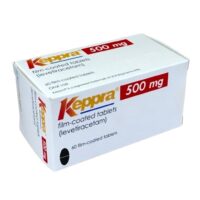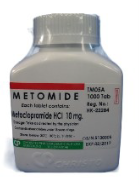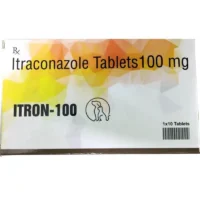描述
Levetiracetam用於犬科動物和貓科動物的概述
Levetiracetam,也稱為 Keppra®,是一種用於治療狗和貓癲癇發作的藥物。它最初與其他癲癇藥物聯合使用,現在通常用作控制癲癇發作的主要手段。當單獨使用苯巴比妥無法提供足夠的益處時,左乙拉西坦通常與苯巴比妥一起使用。
- 使用左Levetiracetam的最大缺點是每天給藥3次,通常不方便。到目前為止,使用Levetiracetam的另一個缺點是成本,由於通用製劑的可用性,成本已經下降。
- Levetiracetam與苯巴比妥併用通常可以減少苯巴比妥的劑量。
- Levetiracetam屬於一類稱為抗驚厥藥的藥物。此類其他相關藥物包括地西泮、溴化鉀和苯巴比妥。
- Levetiracetam的作用機制尚不清楚,但被認為可以防止神經參與的過度同步,從而抑制大腦內神經的興奮性並減少癲癇發作。
- 口服Levetiracetam可快速吸收,約 2 小時內達到高峰效果。
- Levetiracetam可以單獨使用,也可以與另一種癲癇控制藥物苯巴比妥和/或溴化鉀合併使用來控制癲癇發作。
- Levetiracetam是一種處方藥,只能從獸醫處或透過獸醫處方取得。
- 該藥物未經美國食品和藥物管理局批准用於動物,但被獸醫合法處方為標籤外藥物。
Levetiracetam對狗和貓的用途
Levetiracetam用於治療狗和貓的癲癇症,可作為單一療法(單一藥物)或與其他抗驚厥藥物的聯合療法。
注意事項和副作用
- 雖然由獸醫開出Levetiracetam處方通常是安全有效的,但Levetiracetam可能會對某些動物產生副作用。
- Levetiracetam大部分在肝臟外代謝,使其成為肝病患者的熱門選擇,例如肝性腦病變或門體分流術。
- 不建議將Levetiracetam用於懷孕或哺乳的寵物。
- Levetiracetam不應用於已知對該藥物過敏或過敏的動物。
Levetiracetam可能與其他藥物有交互作用。請諮詢您的獸醫,以確定您的寵物正在接受的其他藥物是否可能與Levetiracetam相互作用。藥物可能包括非類固醇類抗發炎藥,如 Rimadyl、Deramaxx 等,以及苯巴比妥。它經常與苯巴比妥一起服用,但劑量通常會減少。
- Levetiracetam對狗最常見的副作用之一是鎮靜作用,這種作用通常是短暫的。噁心和食慾不振是貓咪常見的副作用。
Levetiracetam的供應方式
Levetiracetam有以下配方:
- 口服藥片有 250 mg、500 mg、750 mg 和 1000 mg。
- 500 mg 和 750 g 規格的緩釋口服錠 (Keppra XR®)。
- 口服溶液有 100 mg/mL 的 473 ml、480 l 和 500 ml 規格 (Keppra®)。
- 注射濃縮液,濃度為 100 mg/mL,裝在 5 mL 一次性小瓶中 (Keppra®)。
- Levetiracetam也有通用製劑形式。
- 在未先諮詢獸醫的情況下,切勿服用藥物。如果您擔心與藥物相關的費用,寵物保險可能會有所幫助。
- 對於狗,Levetiracetam通常以每磅 5 至 10 毫克(10 至 20 毫克/公斤)開始,每日 3 次(每 8 小時一次)。緊急治療活動性癲癇發作通常需要更高的劑量,包括高達 20 mg/kg 的劑量。
- 對於貓,Levetiracetam通常以每磅 10 毫克(20 毫克/公斤)開始,每日 3 次(每 8 小時一次)。
- 可能需要增加劑量來控制癲癇發作。
- Levetiracetam可以與食物一起服用。
- 不常規建議進行治療性血液監測。執行時,根據有限的數據,建議的治療範圍為 5-45 µg/mL。當建議調整劑量時,通常在開始使用Levetiracetam後 1 週調整一次,然後每 6 至 12 個月調整一次。
- 給藥持續時間取決於所治療的病情、對藥物的反應以及任何不良反應的發生。一定要完全按照獸醫的指示服用藥物。如果您的寵物的病情發生變化,請在改變或停止劑量或治療持續時間之前諮詢您的獸醫。
Overview of Levetiracetam for Canines and Felines
Levetiracetam, also known as Keppra®, is a drug used to treat
seizures in dogs and cats. Initially used in conjunction with other seizure drugs, it is now commonly used as a primary means of seizure control. Levetiracetam is often used with phenobarbital when phenobarbital alone does not provide adequate benefits.
- The biggest disadvantage to using Levetiracetam is the three times a day dosing, which is often inconvenient. The other disadvantage of using Levetiracetam until now was the cost, which has decreased due to availability of a generic formulation.
- Giving Levetiracetam with Phenobarbital will often allow for decreased doses of Phenobarbital to be given.
- Levetiracetam belongs to a general class of drugs known as anticonvulsants. Other related drugs in this class include diazepam, potassium bromide, and phenobarbital.
- The mechanism of action of Levetiracetam is unclear, but is thought to prevent excessive synchronization of nerve engagement, thus depressing the excitability of nerves within the brain and reducing seizures.
- Levetiracetam is quickly absorbed when given orally with a peak effect in approximately 2 hours.
- Levetiracetam can be used alone or can be combined with another seizure control drug called Phenobarbital and/or potassium bromide to control seizures.
- Levetiracetam is a prescription drug and can only be obtained from a veterinarian or by prescription from a veterinarian.
- This drug is not approved for use in animals by the Food and Drug Administration, but it is prescribed legally by veterinarians as an extra-label drug.
Brand Names and Other Names of Levetiracetam
- Human formulations: Keppra®, now available in generic formulations
- Veterinary formulations: None
Uses of Levetiracetam for Dogs and Cats
Levetiracetam is used to treat
seizure disorders in dogs and cats as either monotherapy (single drug) or combination therapy with other anticonvulsant drugs.
Precautions and Side Effects
- While generally safe and effective when prescribed by a veterinarian, Levetiracetam can cause side effects in some animals.
- Levetiracetam is mostly metabolized outside the liver, making it a popular choice in patients with liver disease, such as hepatic encephalopathy, or portosystemic shunt.
- Levetiracetam is not recommended for use in pregnant or nursing pets.
- Levetiracetam should not be used in animals with known hypersensitivity or allergy to the drug.
Levetiracetam may interact with other medications. Consult with your veterinarian to determine if other drugs your pet is receiving could interact with Levetiracetam. Medications may include non-steroidal anti-inflammatory drugs such as Rimadyl, Deramaxx, and others, as well as Phenobarbital. It is frequently given with Phenobarbital, but the dosage is often decreased.
- One of the most common side effects of Levetiracetam in dogs is sedation, which is generally transient. Nausea and lack of appetite are common side effects in cats.
How Levetiracetam Is Supplied
Levetiracetam is available in the following formulations:
- Oral tablets in 250 mg, 500 mg, 750 mg, and 1000 mg.
- Extended-release oral tablets of 500 mg and 750 g sizes (Keppra XR®).
- Oral solutions are available in 100 mg/mL in 473 ml, 480 l, and 500 ml (Keppra®).
- Injectable concentrate in 100 mg/mL in 5 mL single-use vials (Keppra®).
- Levetiracetam is also available in a generic formulation.
- Medication should never be administered without first consulting your veterinarian. If you’re concerned about costs related to medication, pet insurance may be able to help. Click here to learn more.
- In dogs, Levetiracetam is often started at 5 to 10 mg per pound (10 to 20 mg/kg) three times daily (every 8 hours). Higher doses are often needed for emergency treatment of active seizures, including doses up to 20 mg/kg.
- In cats, Levetiracetam is often started at 10 mg per pound (20 mg/kg) three times daily (every 8 hours).
- Increases in dose may be required to control seizures.
- Levetiracetam can be given with food.
- Therapeutic blood monitoring is not routinely recommended. When performed, the suggested therapeutic range is 5-45 µg/mL based on limited data. When recommended to adjust the dosage, it is generally done 1 week after starting Levetiracetam, then every 6 to 12 months.
- The duration of administration depends on the condition being treated, response to the medication, and the development of any adverse effects. Be certain to administer the medication exactly as directed by your veterinarian. If your pet’s condition changes, consult with your veterinarian before altering or discontinuing the dose or duration of treatment.



